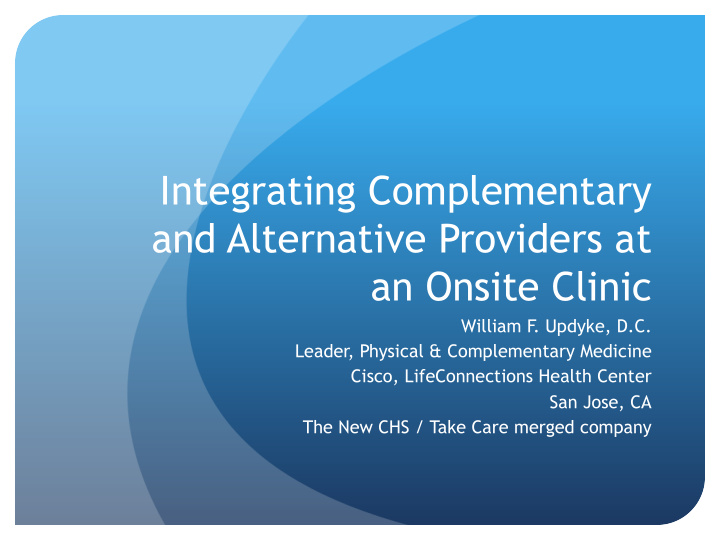



Integrating Complementary and Alternative Providers at an Onsite Clinic William F . Updyke, D.C. Leader, Physical & Complementary Medicine Cisco, LifeConnections Health Center San Jose, CA The New CHS / Take Care merged company
Integrated journey of LCHC a Patient Centered Medical Home Providers Management MD: 15 - 5 Employer MD: 2+1 PT: 8 - 3 Employer Mgr: 1 Acup: 3 - 2 Management Co: 2 DC: 2 - 2 Medical Group MD: 2 +1 EAP: 3 - 1 Clinic Mgr: 4 Health Co: 3 - 1 12 34 - 14
Imagine your employee has a health concern…
Where do your employees go for health care? Percentage of Americans visiting each year Physician: appx 55% Acupuncturist: appx 1% Chiropractor: 7-10%
10% seeing a complimentary provider means….
Evidence based complementary care?
Acupuncture Migraines, episodic or chronic tension-type HA’s Chronic pain, chronic low back pain , neck pain Insomnia Cervical radiculopathy Cancer pain and related symptoms / nausea, etc
Chiropractic Acute and chronic lower back pain Middle back pain Neck pain and headaches Disc herniation and radiculopathy General neuro-musculoskeletal pain
Cost effectiveness of alternative and complementary care? Acupuncture Chiropractic Lower back pain Preventing lower back surgery
Integrating your providers
Provider training and practice experience Historically medical training and alternative / complementary training have not been complimentary to other providers’ approaches – to say the least Training of recent grads is now starting to include integration of some provider types Providers historically trained in direct access (MD/DC/ Acup) generally maintain control of the patient The practical experience of the provider can say a lot about their ability to be open to an integrated clinic
How do you add an integrated provider?
It is no different than adding any other provider to the center Hire provider types your beneficiaries prefer or your health care spending needs Ensure EMR allows for transparency between all providers – visibility and documentation to EMR and secure messaging between all providers Hire the right provider! Success has a track record They will learn your secrets
How does integration it work inside the practice? Patient decides to Patient agrees to see see an acupuncturist the other provider If needed and possible, a If the patients condition is hallway or desk side one that the acupuncturist conversation occurs prior to is comfortable treating the visit between providers they initiate treatment EMR gives visibility access to If there was anything in the non-contracted providers once a business associates history or findings that agreement is signed seemed to indicate the need for that patient EMR allows secure messaging seeing another provider between medical providers they will refer them to that and BAA signed vender provider providers to discuss patient care
How do we integrate at LifeConnections Health Center? Patients can directly access any service Services provided Acupuncture Chiropractic Dental EAP Health Coach Optometry Physical therapy Medical providers
Management options to help integration along Medical group directed evidence based care pathways can be implemented by providers / triage nurse Potentially multiple options based on patient preferences Direct access to alt/comp providers can make triage less important Tracking ICD based referral patterns by each individual provider & reporting to management & openly to all providers allows some integration bias transparency Can identify need for a new line of service Provider meetings with: Case presentations by each provider Group discussions on difficult cases
LCHC’s evolving integrated care model for acu/chiro/PT Over the last year we have initiated one visit multi provider treatments Initial provider makes decision to include new provider Considering adding medical, EAP and others Tracking outcomes
Thank you! William Updyke, DC Bill.updyke@takecarehealth.com Surfdoc1@aol.com Cell: 415-279-9471
Recommend
More recommend